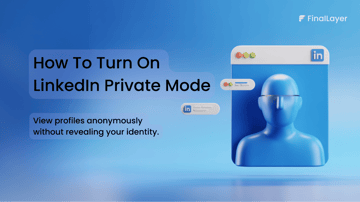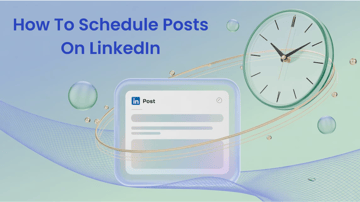Most companies make critical mistakes that render their job postings invisible to qualified candidates. They use internal job titles that nobody searches for, create lengthy descriptions that read like legal documents, and miss essential SEO opportunities that could dramatically increase their reach.
This comprehensive guide reveals the proven strategies behind successful LinkedIn job posting optimization and management. You'll discover how to craft compelling 250-word job descriptions that drive action.
Whether you're a startup building your employer brand or an established company refining your recruitment strategy, these insights will help you stand out in LinkedIn's competitive job marketplace.
Understanding LinkedIn Job Posting Fundamentals
LinkedIn offers two primary approaches to job advertising: the first option involves paid job listings that appear directly in LinkedIn's job board database, while the second allows you to post free career page links on your company page.
The platform operates on a pay-per-click model for paid listings, meaning you only invest when users actually view your job posting.
LinkedIn's job board functions as a comprehensive database where active job seekers can filter opportunities by experience level, posting date, location, and remote work options.
For smaller companies still building their LinkedIn presence, paid job listings offer significant advantages in reaching candidates who may not be familiar with their brand..
Conversely, established companies with large followings can effectively leverage free career page posts to engage their existing network and followers.
Crafting Compelling Job Titles and Descriptions
A well-crafted job posting should be approximately 250 words and focus on three essential elements.
First, clearly communicate the impact and significance of the role within your organization.
Second, provide realistic insights into everyday activities and responsibilities.
Third, outline mandatory requirements without overwhelming candidates with an endless wish list.
Opt for industry-standard titles that align with what your target audience actively searches. A "Content Marketing Manager" will always perform better than a "Brand Storytelling Specialist" in search results.
When writing job descriptions, avoid buzzword bingo and generic phrases that provide no real value.
Terms like "highly collaborative team players," "passionate leaders," or "results-driven professionals" appear in thousands of job postings daily. Instead, provide concrete examples and context for required skills.
How to Post a Job on LinkedIn: Step-by-Step Guide
Share your insights about the topic by creating a LinkedIn post
What LinkedIn job posting secrets do top recruiters use?
You will have a chance to edit later
Log in to your LinkedIn account, navigate to the upper menu bar, and click on "Jobs" to access the LinkedIn Jobs section.
Click on the "Post a job" link to start the job posting creation workflow.
Fill in the fundamental job details including job title, company name, location (remote, on-site, or hybrid), and employment type (full-time, part-time, contract, etc.).
Craft a compelling job description that includes responsibilities, requirements, qualifications, and company information. Use LinkedIn's formatting tools to make your posting clear and engaging.
Choose how candidates will apply - either through LinkedIn's built-in application system or by redirecting to your company website's application portal.
Select your target audience parameters, set your posting duration, and choose whether to promote your job posting with LinkedIn's paid promotion options.
Double-check all information for accuracy, preview how your job posting will appear to candidates, and click "Post job" to make it live on LinkedIn's platform.
SEO Optimization Strategies for Job Postings
SEO optimization for LinkedIn job postings involves strategic keyword integration that goes far beyond simply stuffing terms into your content.
Your primary keywords should appear in the job title, opening paragraph, and throughout the description in a natural flow.
Key SEO elements that dramatically impact your posting's visibility include job titles with industry-standard terminology, location-based keywords for local searches, and skills-based keywords that match candidate profiles.
LinkedIn's search algorithm considers multiple factors when ranking job postings, including response time to applications, complete profile information, and engagement metrics.
Filling out all available fields - salary range, employment type, company size, and industry - significantly improves your posting's visibility and helps candidates make informed decisions.
Cost Management and Budget Optimization
LinkedIn's pay-per-click model provides exceptional flexibility in budget management, allowing you to set daily spending limits and receive intelligent budget recommendations based on similar job postings in your industry and location.
Daily budget limits provide crucial spending control, preventing unexpected costs during high-traffic periods. Set budgets based on your application volume goals rather than arbitrary amounts.
Free posts cost nothing upfront; they typically generate limited reach and require significant social media amplification to achieve meaningful visibility.
Application Management and Screening
LinkedIn's application management system includes powerful screening tools that help filter candidates before they reach your inbox.
The platform offers both templated screening questions and custom question options, allowing you to assess specific qualifications, experience levels, and certifications.
Must-have qualification filters automatically reject applications from candidates who don't meet essential requirements.
The platform's automatic rejection system for unqualified candidates saves time in initial screening phases. However, carefully consider your "must-have" qualifications to ensure you don't inadvertently filter out strong candidates.
Advanced LinkedIn Job Posting Strategies
Video Job Postings
Create short, authentic videos featuring team members discussing the role, company culture, or day-in-the-life experiences to generate significantly higher engagement rates compared to standard text descriptions.
Sponsored post amplification
Boost individual job posts with LinkedIn's paid promotion options to increase visibility beyond your organic reach and target specific candidate demographics more effectively.
Targeted advertising integration
Combine job postings with LinkedIn's advanced targeting capabilities to reach passive candidates who match your ideal candidate profile but may not be actively job searching.
Company page enhancement
Regularly share content, encourage employee advocacy, and engage with your network to improve your company's overall LinkedIn visibility, which benefits all recruitment efforts through improved organic reach.
Consistent Brand Building
Maintain an active company presence through regular updates, industry insights, and company news to establish credibility and attract quality candidates organically.
Thought leadership content
Share industry insights, expert opinions, and forward-thinking content to position your organization as an industry leader and employer of choice before candidates encounter your job postings
Integration with Broader Recruitment Strategy
Employer brand development
Share company culture content, employee spotlights, and industry insights regularly to establish your organization as an attractive workplace before candidates see job postings
Talent pipeline nurturing
Build relationships with potential candidates months or years before hiring needs arise through proactive networking and engagement with industry professionals
Cross-platform campaign coordination
Amplify LinkedIn efforts by sharing job postings on company social media, email newsletters, and industry forums to increase visibility beyond LinkedIn's native audience
Employee referral program integration
Leverage your team's networks by encouraging employees to share job postings with their LinkedIn connections, often generating higher-quality applications than cold posting
Long-term candidate relationship
Stay connected with promising candidates not selected for current roles, as these relationships often result in successful hires for future opportunities or valuable referrals.
Conclusion
LinkedIn job posting optimization and management requires a strategic approach that combines compelling content creation, SEO optimization, targeted audience management, and data-driven decision making. Success on the platform depends on understanding its unique features, from pay-per-click pricing to sophisticated targeting capabilities, while adapting to ongoing algorithm changes and mobile-first user behavior.
As LinkedIn continues to innovate and expand its recruitment features, staying informed about platform changes and best practices will ensure your job postings remain competitive and effective.




































































